Well, that was unexpected.
Not the return of Slivers, although the combination of “broken casual mechanic” plus “broken tournament mechanic” in The First Sliver is sweet. And not the release of a long-awaited Urza card, although I think he’s a worthy representation of the character in pre-Planeswalker guise. No, I’m surprised by how guarded and anemic my predictions from Part One look in retrospect, now that spoilers for Modern Horizons have started dropping.
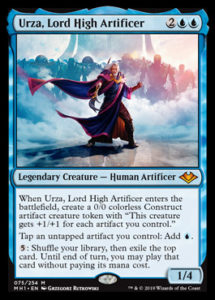
Last week’s spoilers were weirder and broader than I expected them to be. I thought I had a handle on Modern Horizons. I expected it to be “Auxiliary Set Masters,” packed full of Conspiracy/Commander reprints and low-impact but nostalgic cards from 1999-2002—Fact or Fiction, etc. Not only did we get a free counterspell, but we got a cycle of pitch spells, albeit of varying quality. We didn’t just get a throwback legend or two—we got an apparent cycle and a new two-mana “lands matter” Planeswalker. I certainly wasn’t expecting a single-shot Umezawa’s Jitte, or a new Mox, or Bear Tribal, or a Level Up mini-Progenitus, or a Sliver lord that truly feels as dominating and exciting as Sliver Queen did back in 1998. I’m guilty of lowered expectations, I suppose, and it made me conservative in my estimations of the set.
I’ve never been happier to be wrong.
Modern Horizons isn’t Magic’s Greatest Hits, or an engineered shake-up of the format, or a disruptive tactic by Wizards designed to define the format for eventual migration to Arena. It’s a victory lap, an artistic statement, a self-reflection in an uncertain time. It isn’t a couple of hundred instant staples or omnipresent solutions or silver bullets; but a weird, shaggy set full of in-jokes and quixotica. There are more Changelings to be Goatnapped, more Ninjas to sneak out, more one-drops to tutor up.
I can’t speak to how the set will affect Modern just yet; but it’s been designed for Limited, if nothing else, and I’ve been inspired by some of the choices. There’s a thoughtfulness to the design that reminds me of Dominaria, with some of Battlebond’s craziness thrown in. But as Mark Rosewater has mentioned several times, the true model for the set was Time Spiral, Magic’s only truly postmodernist set. Of what we’ve seen so far—and it’s only Monday, and there’s so much left to see—the cards that excite me most aren’t necessarily the ones I expect to shuffle up at Modern Night; but the ones that tell a story, that open the door to new experiences through old vernacular. These cards, in fact:
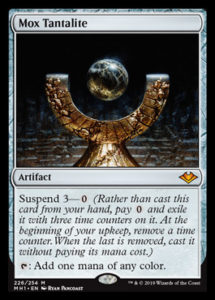
It’s my conviction that bad Moxen don’t dilute the Mox brand—they bolster the legend of the original five. So I don’t hate Mox Tantalite, even though I think it’s unplayable—it’s hard to hate such an oddball card. The name is also extremely clever: “tantalite” is an outdated term for a kind of tantalum-rich ore, which is used for electronic components and medical technology when refined, and it comes from the same mythic root as the word “tantalize.”
Tantalus was a Grecian king—the son of Zeus in some versions—who murdered and cooked his son and served his corpse to the gods. When they discovered his crime, they sentenced him to a poetic justice: to be cursed by thirst and hunger, and to be unable to reach the food above him or bend to drink the water in which he was immersed. The name is Wizards directly challenging us: you’ll never break this, but you’ll long to try.
In contrast, Mox Amber will, at some point, have a critical mass of cheap and playable legends to back it up. It might be 2026, but as long as the game lives, it’ll be slowing accruing value and becoming an incrementally stronger card. Mox Tantalite will theoretically increase in playability—but only because it’s hard to imagine how it could be worse. It’ll sit in your binder, periodically spiking as new sets release, settling back into obscurity as it flames out again and again. One day, an Auriok Salvagers variant may break it; one year, an As Foretold deck will want it. Until then, it’ll tantalize us.
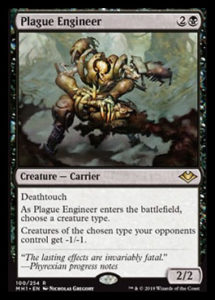
While I love the design of Plague Engineer, I don’t expect this to see more than minimal play. It would have to kill at least one thing upon entering, and the top decks in Modern are either running too many lords (Spirits, Humans) or have already gotten value from their creatures hitting the battlefield (Grixis, Phoenix). Will I still try to end step two of these out with Collected Company in a Rock deck? Absolutely, and it’ll be worth it to see those Arclights stranded in the yard.
I do adore the callback to the Phyrexian carriers, as I used to jam that deck in seventh-grade English class back in 1999. It’s worth noting that the Carrier cycle was much better pre-M10—you could block and then activate the ability with damage on the stack, so Phyrexian Debaser could take down Serra Angel by its lonesome. Phyrexian Plaguelord, backed up by Deranged Hermit, was the genesis of “The Rock” archetype, and the first deck to introduce me to the joy of sacrificing creatures for value. Speaking of which:
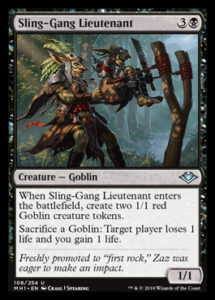
I had hopes for Goblin Bombardment, but a zero-cost sacrifice outlet that hits any target is just too dangerous. If only we had Gravecrawler that was a Goblin, we’d be in business. As is, I love this as a tutorable target for Goblin Matron and a useful closer for Wort, Boggart Auntie in Commander.
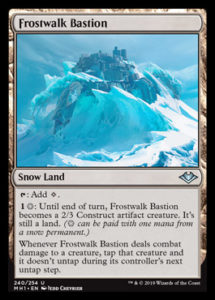
The reprinting of Snow-Covered lands and the snow subtheme in the set means it’s now possible to build a snow manabase for decks other than Skred Red. Scrying Sheets, Frostwalk Bastion, and snow basics feels like nothing so much as Tempest-era Magic, when control decks ran Thawing Glaciers for stability and virtual card advantage and Stalking Stones to close out the game. Whether this strategy holds any worth twenty years later is suspect, but pure Draw-Go has never felt closer to possible in Modern.
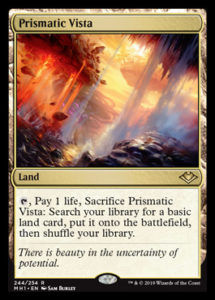
It seems weird that Prismatic Vista can fetch Wastes. I look forward to Wastes being a theme in Modern Horizons 3, whenever that arrives—Waste duals is something I’ve found myself wanting in deckbuilding.
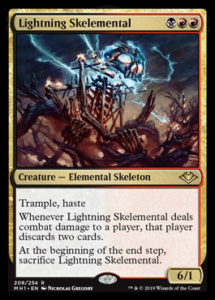
“Ball Blightning” is the obvious reference, but I’m more amused by the suggestion that turning RRR into BRR apparently skeletonizes something (as does 4R, per Skeletonize). If that holds true (obviously it won’t), I’m looking forward to Skeleton Assault, which presumably lets you discard lands to make your opponent discard a card and deal two, and to Skeleton Chainwhirler, which doesn’t need more card advantage built in to succeed.
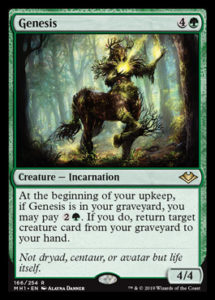
Back in the day—circa 2002 through to the advent of Commander—Genesis was an absolute behemoth in 60-card casual. With Sakura-Tribe Elder, it was 3GG for Rampant Growth every turn; with Yavimaya Elder, it was an expensive build-your-own-Recall engine. Now, our graveyard fodder is more Bloodghast or Arclight Phoenix than Genesis, and we don’t pay mana to return our cards to the battlefield. It’s still a blast in Limited, though.
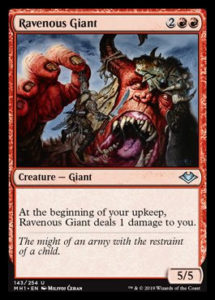
Similarly, Ravenous Giant—simply a color shifted Juzam Djinn—will prove itself to be outmoded and underpowered. Juzam itself is still a powerhouse in Old School and an iconic card, but would be $2.00 were it not one of the most atmospheric works of art early Magic produced. The saturated colors, the Mark Tedin art, the slate color of the card—it’s a brand in a box and an underrespected component of Magic’s early success. Ravenous Giant, meanwhile, will be a reasonable card in your draft deck and then an answer to a trivia question for years to come. That’s Magic looking back on its past with a critical eye, and it’s emblematic of the best parts of Time Spiral block.
We still, at the time of writing, have more than half of the set to go, so there may yet be surprises—although perhaps not what I anticipated. Let’s go back through my pitiful prognostications and see how I did:
Containment Priest: Not spoiled, and not likely, since it would be between Battle Screech and Dismantling Blow. I suppose Force of Despair will have to do, even if its one-shot and doesn’t come on a creature.
A single Infect card: Nope, but I have hope still.
Snow-Covered Lands: Sure, but this was all but a lock.
Grim Tutor or an Ancient Stirrings-style top X cards tutor: Big no.
Proactive hate cards: 5 points for Plague Engineer . . . out of 100.
Mass removal: Weirdly enough, nothing yet, aside from Winds of Abandon
Long-lost mechanics: “My dream is to see Wizards revisit Splice and shift it to ‘Splice onto Instant’ or ‘Splice onto Sorcery.’”
Anti-Burn hate, in the manner of Chill: Nope!
Enchantress assistance: Zilch so far.
Cursed Totem-style prison card: Pithing Needle, Grafdigger’s Cage, and Deadlock Trap remain our best options. Okay, just the first two.
There’s a reason I write about the game and don’t design it. As humbling as my failed predictions were, I’m glad this is the set we’ve ended up with. I expected a combination Core Set/Modern Masters set, and we got Time Spiral’s sequel instead. This feels, more than anything, like Magic design as art, rather than commerce—it’s the Wizards team looking back upon twenty-five years and summing up what worked and what could have been better tweaked. Magic’s future is secured, although in the e-sports age I anticipate it changing; and this feels, like Kaladesh’s reinterpretation of resource management and Dominaria’s rewriting and representation of history, like a statement of purpose for that security. All that and Skelementals, too.
A lifelong resident of the Carolinas and a graduate of the University of North Carolina, Rob has played Magic since he picked a Darkling Stalker up off the soccer field at summer camp. He works for nonprofits as an educational strategies developer and, in his off-hours, enjoys writing fiction, playing games, and exploring new beers.

